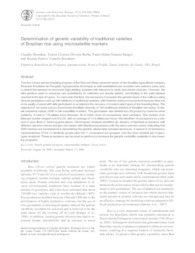Determination of genetic variability of traditional varieties of Brazilian rice using microsatellite markers.
Determination of genetic variability of traditional varieties of Brazilian rice using microsatellite markers.
Author(s): BRONDANI, C.; BORBA, T. C. O.; RANGEL, P. H. N.; BRONDANI, R. P. V.
Summary: The rice (Oryza sativa) breeding program of the Rice and Bean research center of the Brazilian agricultural company Empresa Brasileira de Pesquisa Agropecuária (Embrapa) is well established and provides new cultivars every year to attend the demand for improved high yielding varieties with tolerance to biotic and abiotic stresses. However, the elite genitors used to compose new populations for selection are closely related, contributing to the yield plateau reached in the last 20 years. To overcome this limit, it is necessary to broaden the genetic basis of the cultivars using diverse germplasm such as wild relatives or traditional varieties, with the latter being more practical because they are more easily crossed with elite germplasm to accelerate the recovery of modern plant types in the breeding lines. The objective of our study was to characterize the allelic diversity of 192 traditional varieties of Brazilian rice using 12 simple sequence repeat (SSR or microsatellite) markers. The germplasm was divided into 39 groups by common name similarity. A total of 176 alleles were detected, 30 of which (from 23 accessions) were exclusive. The number of alleles per marker ranged from 6 to 22, with an average of 14.6 alleles per locus. We identified 16 accessions as a mixture of pure lines or heterozygous plants. Dendrogram analysis identified six clusters of identical accessions with different common names and just one cluster with identical accessions with the same common name, indicating that SSR markers are fundamental to determining the genetic relationship between landraces. A subset of 24 landraces, representatives of the 13 similarity groups plus the 11 accessions not grouped, was the most variable set of genotypes analyzed. These accessions can be used as genitors to increase the genetic variability available to rice breeding programs.
Publication year: 2006
Types of publication: Journal article
Unit: Embrapa Rice & Beans
Keywords: Arroz, Brasil, Microsatellite markers, Oryza Sativa, Recurso Genético, rice
Observation
Some of Embrapa's publications are published as ePub files. To read them, use or download one of the following free software options to your computer or mobile device. Android: Google Play Books; IOS: iBooks; Windows and Linux: Calibre.
Access other publications
Access the Agricultural Research Database (BDPA) to consult Embrapa's full library collection and records.
Visit Embrapa Bookstore to purchase books and other publications sold by Embrapa.

